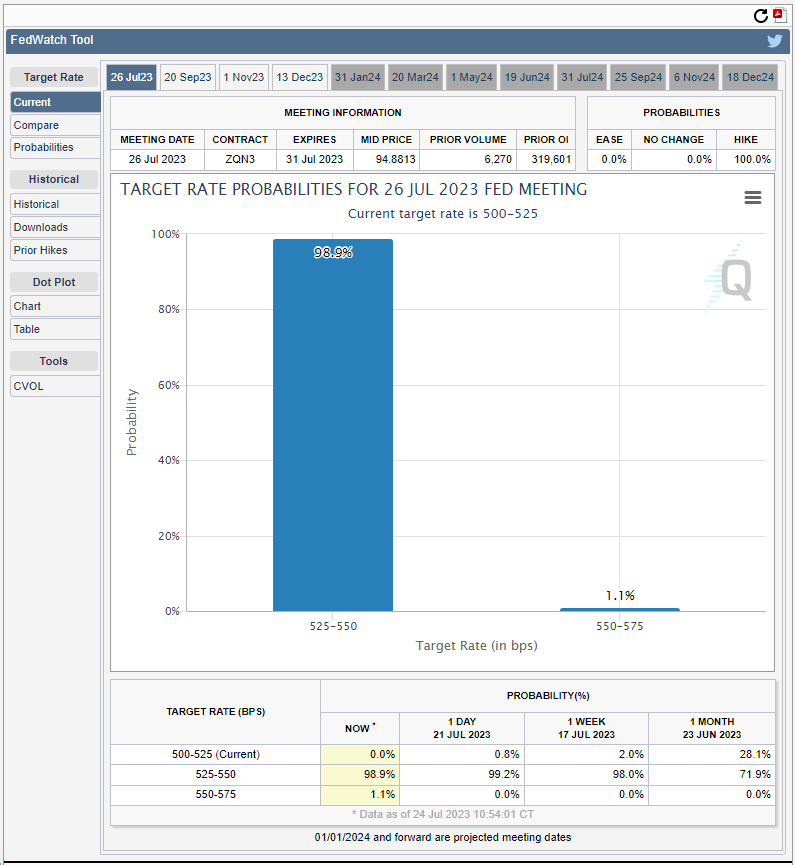The global oil market has seen significant moves recently. This article will tell the reasons behind the surge in oil prices.
Production cuts and economic support
The oil market experienced a boost, primarily due to production cuts from major players in the Organization of the Petroleum Exporting Countries and their allies (OPEP+), notably Saudi Arabia and Russia. These reductions, combined with potential economic support from China, have played a pivotal role in the upward trend of oil prices.
Russia's commitment to reducing its exports by approximately 400,000 barrels per day in July and 500,000 barrels per day in August further solidifies the market's confidence in the upward trajectory of crude prices.
WTI Oil peaks
U.S. West Texas Intermediate (WTI) oil prices concluded at their highest in three months, reinforcing the market's belief in Saudi Arabia and Russia's commitment to volume reductions.
Saudi Arabia's announcement in June about its intention to cut production by one million barrels per day in July and August, coupled with Russia's promise to reduce its exports by 500,000 barrels per day next month, has significantly influenced this trend.
Caution ahead of the Fed meeting – CME FedWatch tool
Despite the bullish trend, the oil market's momentum seemed to wane as it approached the Federal Reserve's meeting, which holds significant implications for the global economy (see below chart on probabilities of an interest rate hike).
The probability of a Fed rate hike at this week's FOMC is close to 100%. The US Federal Reserve should therefore increase its rates by 25 basis points to 5.25-5.50%.
In conclusion, while voluntary production cuts by major global producers like Saudi Arabia and Russia have bolstered oil prices, concerns about China's economic slowdown and its impact on oil demand remain. The market's focus has now shifted to the Federal Reserve and the European Central Bank's monetary policy decisions, which are expected to influence global economic optimism and, consequently, oil demand forecasts.
As the global oil market continues to evolve, several questions arise:
How will the decisions of the Federal Reserve and the European Central Bank impact the future trajectory of oil prices?
With the ongoing economic challenges in China, what measures will Beijing introduce to stabilize its economy, and how will these actions influence global oil demand?
Share your thoughts and insights in the comments below.
Chart: US Dollar Currency Index (DXY/USDX)
US Dollar Currency Index – CFD
Chart: Energy Futures (CL; NG; RB; HO)
WTI Crude Oil (CL); Natural Gas (NG); RBOB Gasoline (RB); Heating Oil (HO) – Continuous Futures contracts (4H charts)
Want free follow-ups to the above article and details not available to 99%+ investors? Sign up to our free newsletter today!
All essays, research and information found above represent analyses and opinions of Przemyslaw Radomski, CFA and Sunshine Profits' employees and associates only. As such, it may prove wrong and be a subject to change without notice. Opinions and analyses were based on data available to authors of respective essays at the time of writing. Although the information provided above is based on careful research and sources that are believed to be accurate, Przemyslaw Radomski, CFA and his associates do not guarantee the accuracy or thoroughness of the data or information reported. The opinions published above are neither an offer nor a recommendation to purchase or sell any securities. Mr. Radomski is not a Registered Securities Advisor. By reading Przemyslaw Radomski's, CFA reports you fully agree that he will not be held responsible or liable for any decisions you make regarding any information provided in these reports. Investing, trading and speculation in any financial markets may involve high risk of loss. Przemyslaw Radomski, CFA, Sunshine Profits' employees and affiliates as well as members of their families may have a short or long position in any securities, including those mentioned in any of the reports or essays, and may make additional purchases and/or sales of those securities without notice.
Recommended Content
Editors’ Picks

Gold trades around $3,050, higher highs ahead
Relentless tariff jitters, coupled with renewed weakness in the US Dollar, have propelled gold prices back toward record territory—hovering just above $3,060 per troy ounce.

EUR/USD sticks to the bid bias, still below 1.0800
The renewed selling pressure in the US Dollar continues to underpin the improvement in the risk complex and motivates EUR/USD to reverse part of the multi-day decline with the next target at 1.0800 the figure.

GBP/USD looks firm near 1.2950, Dollar retreats
The selling pressure on the Greenback motivates GBP/USD to regain upside traction, leave behind Wednesday's hiccup and refocus on the 1.2950 region and beyond on Thursday.

Crypto Morning: BlackRock spends $107 million on Bitcoin, stablecoin launches, Shiba Inu boss still offline
BlackRock, a giant with $11.5 trillion in assets under management, spent $107.9 million to fund its BTC purchase on Wednesday. The move is consistent with demand for BTC among institutional investors.

US: Trump's 'Liberation day' – What to expect?
Trump has so far enacted tariff changes that have lifted the trade-weighted average tariff rate on all US imports by around 5.5-6.0%-points. While re-rerouting of trade will decrease the effectiveness of tariffs over time, the current level is already close to the highest since the second world war.

The Best brokers to trade EUR/USD
SPONSORED Discover the top brokers for trading EUR/USD in 2025. Our list features brokers with competitive spreads, fast execution, and powerful platforms. Whether you're a beginner or an expert, find the right partner to navigate the dynamic Forex market.


